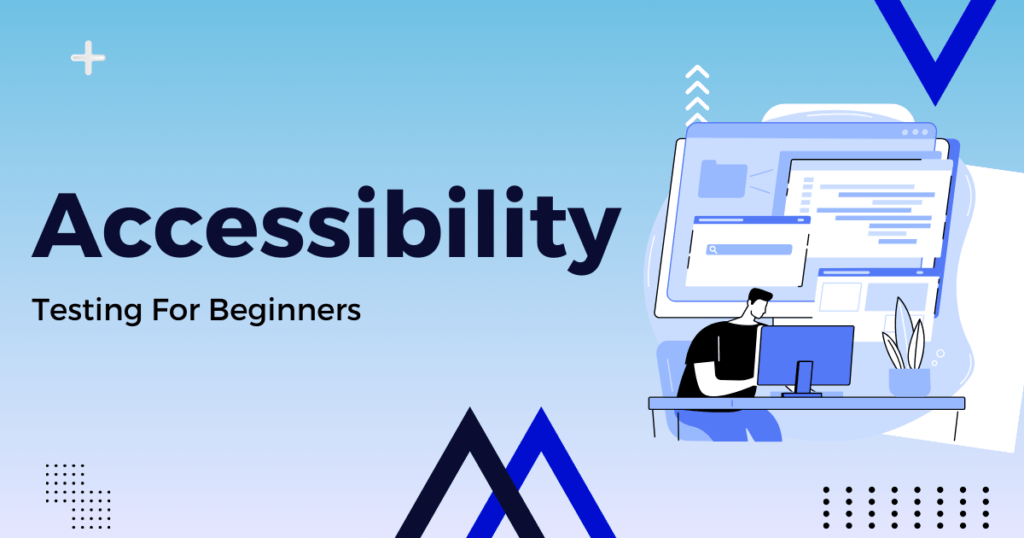In the digital age of today, it is not only a legal obligation, but also a moral one to ensure that your website or app is accessible for everyone, including those with disabilities. In this process, accessibility testing is crucial because it identifies and addresses barriers that prevent users with disabilities from effectively using digital content.
This comprehensive guide is for those who are new to accessibility testing. It will help them understand the importance of it, its key principles and how to start.
What is accessibility testing?

The accessibility test evaluates the ease of use of a website or an application for people with different disabilities. These include visual, auditory and physical impairments, as well as cognitive, language, learning and neurological impairments. It is important to make digital content accessible to everyone, no matter what their ability.
Why is accessibility testing important?
- Inclusivity: Make sure that your digital content is accessible to all users regardless of their disability.
- Legal Compliance: There are many laws and regulations in place (such as the Americans with Disabilities Act and the Web Content Accessibility Guidelines) which require that digital content is accessible.
- Enhance User Experience: Makes content easier to navigate and understand.
- Market Reach: By including people with disabilities in your target audience, you can increase the number of potential users and improve customer satisfaction.
- SEO Benefits – Accessible websites rank higher in search engines because of their improved structure and usability.
Accessibility: Key Principles
The WCAG outlines the four main principles for accessibility. They are often referred to as POUR:
- Perceivable – Information and user interface elements must be presented so that the users can understand them. Text alternatives are needed for content that is not text-based, and content must be adaptable.
- Operable: Navigation and user interface components must be operable. All functionality should be accessible from a keyboard, and users must have enough time to read the content and use it.
- Understanding: The information and operation of the user interface should be understood. Text should be readable, predictable and input-assistance provided.
- Robustness: The content must be robust to allow it to be reliably understood by a variety of user agents including assistive technology. Compatibility with existing and future tools is important.
Get Started with Accessibility Tests
1. Follow the Guidelines
Familiarize your self with the WCAG Guidelines. Understanding these standards gives you a solid basis for accessibility testing.
2. Use Accessibility Tools
You can use several tools to identify accessibility issues.
- Automated Tools : Tools such as WAVE, Axe and Lighthouse scan your website to identify accessibility issues. They then provide reports that detail what needs to be corrected.
- Screen Readers: Tools such as JAWS (Jaws), NVDA (NVDA) and VoiceOver help you to understand how visually impaired users perceive your content.
- Colour Contrast Analysis Tools: Color Contrast Analysis tools help you ensure that your text can be read against the background colors.
Ready to enhance your software quality and accelerate your time to market? Contact us today at sales@stelotechnology.com to request a customized quote for your business!
3. Manual Testing
The automated tools are fantastic, but they don’t cover everything. Manual testing includes navigating the website with only a keyboard and screen readers. It also involves evaluating usability by people who have cognitive and motor disabilities.
4. Check Keyboard Accessibility
Verify that you can access and use all interactive elements with a keyboard (buttons, forms, links). Test tab navigation, and ensure there are no keyboard-traps.
5. Test Assistive Technologies
You can use screen readers or other assistive technology to navigate the site. This will allow you to understand how people with disabilities interact with your site.
6. Evaluate Color Contrast
Text and interactive elements should have enough contrast with their backgrounds. It is helpful for users who have color blindness or visual impairments.
7. Please provide alternative text
Text alternatives should be provided for all non-text content such as audio and video (e.g. alt text for videos, transcripts for audio).
8. Make sure Forms are Accessible
Instructions and labels should be clearly visible on all forms. You should ensure that users can navigate through forms using keyboards and screen readers.
9. Use Semantic HTML
By providing a meaningful structure to the content, HTML elements like headings, buttons, and lists can improve accessibility.
10. Test User Interfaces
Include users with disabilities as part of your testing process. Their feedback can be invaluable and provide insight that automated or manual testing may miss.
The conclusion of the article is:
It is important to test your digital content for accessibility. You can create accessible and inclusive websites and apps by following the guidelines in this guide. Accessibility is not just a one-time thing, but a commitment to inclusivity.
Make your digital content accessible to all users by implementing accessibility testing now!


